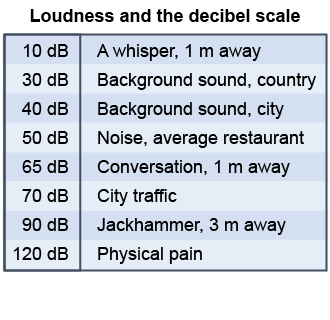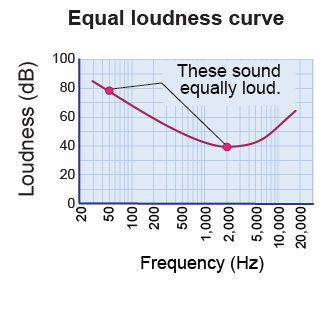|
 Loudness describes the perception of sound by your ear and brain. The loudness of sound is mostly determined by the amplitude of a sound wave. We say mostly because, to a human ear, the frequency also matters. A high-amplitude sound at a frequency of 40,000 Hz is silent to a human ear but quite loud to a bat! We use the decibel (dB) scale to measure noise levels because the human ear can respond to such a wide range of pressure changes. Zero decibels corresponds to the smallest pressure change that a healthy young listener can detect. Most sounds fall between 0 and 100 on the decibel scale, making it a very convenient set of numbers to understand and use.
Loudness describes the perception of sound by your ear and brain. The loudness of sound is mostly determined by the amplitude of a sound wave. We say mostly because, to a human ear, the frequency also matters. A high-amplitude sound at a frequency of 40,000 Hz is silent to a human ear but quite loud to a bat! We use the decibel (dB) scale to measure noise levels because the human ear can respond to such a wide range of pressure changes. Zero decibels corresponds to the smallest pressure change that a healthy young listener can detect. Most sounds fall between 0 and 100 on the decibel scale, making it a very convenient set of numbers to understand and use. 
|
The decibel scale is logarithmic. In a logarithmic scale, equal intervals correspond to multiplying by 10 instead of adding equal amounts. For sound, every increase of 20 decibels (dB) means that the wave has 10 times greater amplitude. This is different from the linear scales you are familiar with. On a linear scale, going from 100 to 120 means that the amplitude increases by 20%. On a logarithmic scale, going from 100 to 120 dB means that the amplitude increases by a factor of 10—for example, from 100 to 1,000! Logarithmic scales are useful because they allow us to represent large ranges with convenient numbers. For example, sound waves with amplitudes from 0.00002 N/m2 to 20 N/m2 (also called pascals or Pa) can be represented by values from 0 to 120 on the decibel scale. The Richter scale for earthquake magnitude is also a logarithmic scale. 
|
The perception of loudness depends on frequency as well as amplitude. Sounds below 20 Hz or above 20,000 Hz are not perceived at all by the average human ear. A large amplitude sound wave at a frequency of 30,000 Hz is totally inaudible to a person. Of course, other animals have different sensitivities and this sound would be quite loud to a bat, which can hear frequencies past 100,000 Hz. 
|
 Even within the range of hearing, the perceived loudness is affected by frequency. The equal loudness curve shows how sounds of different frequencies compare in perceived loudness to an average human ear. Sounds near 2,000 Hz seem louder than sounds of other frequencies, even at the same decibel level. For example, the equal loudness curve shows that a 40 dB sound at 2,000 Hz sounds just as loud as an 80 dB sound at 50 Hz. The human ear is most sensitive to sounds between 300 and 3,000 Hz. The ear is less sensitive to sounds outside this range. Not coincidentally, most of the frequencies that make up speech lie between 300 and 3,000 Hz.
Even within the range of hearing, the perceived loudness is affected by frequency. The equal loudness curve shows how sounds of different frequencies compare in perceived loudness to an average human ear. Sounds near 2,000 Hz seem louder than sounds of other frequencies, even at the same decibel level. For example, the equal loudness curve shows that a 40 dB sound at 2,000 Hz sounds just as loud as an 80 dB sound at 50 Hz. The human ear is most sensitive to sounds between 300 and 3,000 Hz. The ear is less sensitive to sounds outside this range. Not coincidentally, most of the frequencies that make up speech lie between 300 and 3,000 Hz. 
|
| |
|

